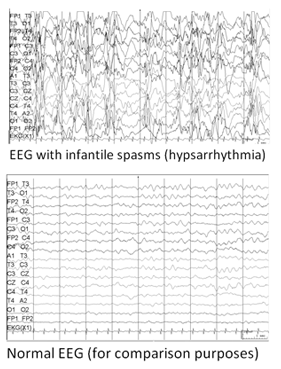Infantile Spasms
Infantile spasms (also called "West syndrome") are a generalized seizure disorder characterized by clusters of sudden flexor or extensor jerks in infants less than 1 year of age. It occurs in 1 in 2000 children, typically 4-8 months of age. It is often associated with both an arrest in development and the EEG pattern of "hypsarrhythmia". Although the long-term outcomes are not very good, it frequently has much to do with the underlying reason for spasms (and if there is a brain malformation or genetic disorder, it is likely to be worse than if no cause is found). Most neurologists treat this condition as medical emergency as there is evidence that treating aggressively (in some cases within 1 month) helps long-term outcome.
Corticosteroids are widely used and often help – in about 2/3 of patients. Options include ACTH injections and oral prednisolone (Prelone). The physicians at Johns Hopkins and many other places prefer to use oral prednisolone due to similar efficacy, greater ease of use, and much lower cost. Side effects do exist and include gastroesophageal reflux, edema, weight gain, irritability and increased chances of infection.
Vigabatrin is also used for infantile spasms and works in about half of children. However, it can cause an irreversible change to the retina and peripheral vision - which is very difficult to test for and prevent. Vigabatrin's effect on vision appears to be more likely with long-term (>6 month) use. It is very effective for the infantile spasms caused by tuberous sclerosis complex.
 Sodium valproate and clonazepam have had only limited success in abolition of seizures. Relatively newer drugs, such as topiramate, lamotrigine, zonisamide, and ganaxolone, have been tested for infantile spasms but have limited efficacy with their own side effects. Pyridoxine (Vitamin B6) does not appear to be helpful.
Sodium valproate and clonazepam have had only limited success in abolition of seizures. Relatively newer drugs, such as topiramate, lamotrigine, zonisamide, and ganaxolone, have been tested for infantile spasms but have limited efficacy with their own side effects. Pyridoxine (Vitamin B6) does not appear to be helpful.
The ketogenic diet is a therapy that can be very helpful for infantile spasms, and is worldwide considered a reasonable 3rd line drug if corticosteroids and vigabatrin don't work. In a large series of 104 infants from Johns Hopkins published in 2010, nearly 2/3 (64%) responded to the diet, with 37% spasm-free for at least 6 months. Using the diet sooner appeared to be better.
As a result of this, the diet is sometimes used first (before medications), as was the case for Carson. Johns Hopkins published their results in 2008 giving the diet a 2-week try for infants who are brought in quickly. In general, the diet works about 50% of the time as a first-line treatment. When it works, it's usually effective within a week and then the diet is continued for 6 months. If it doesn't help, then steroids are usually recommended.
Related Articles
http://www.epilepsy.com/epilepsy/epilepsy_infantilespasms
http://en.wikipedia.org/wiki/West_syndrome
http://www.epilepsyfoundation.org/about/types/syndromes/infantilespasms.cfm












